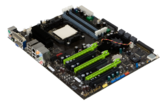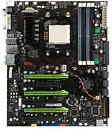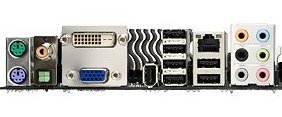Friday, March 27th 2009

NVIDIA nForce 980a SLI Reference Platform Motherboard Pictured
Pursuing legal action against Intel for bringing its Intel-compatible platform development to a grinding halt due to legal complications, NVIDIA has kept its platform development for AMD on track. The company has made the nForce 980a SLI platform official, that supports the latest Phenom II series processors from AMD. The company published the product page on its website, and has pictured its reference design motherboard based on the chipset. The motherboard carries the "designed by NVIDIA" marking, which makes it a design that several of its AIC partners such as EVGA, XFX, Zotac, etc., can use simultaneously.
The motherboard sports the nForce 980a SLI chipset, paired with the nForce 200 PCI-Express bridge chip. The motherboard features a GeForce 8300-class IGP, with DVI-D and D-Sub outputs. It supports NVIDIA 3-way SLI and Quad-SLI. As an AMD platform, the chipset supports AM2, AM2+ and AM3 socket processors, with DDR3 and DDR2 memory support (depending on the processor). A 5-phase digital PWM circuit powers the processor. The nForce 980a SLI and nForce 200 chips are located adjacent to each other, and are cooled actively by a fan-heatsink. The product design looks production-grade and may attract partners to sell it.
The motherboard sports the nForce 980a SLI chipset, paired with the nForce 200 PCI-Express bridge chip. The motherboard features a GeForce 8300-class IGP, with DVI-D and D-Sub outputs. It supports NVIDIA 3-way SLI and Quad-SLI. As an AMD platform, the chipset supports AM2, AM2+ and AM3 socket processors, with DDR3 and DDR2 memory support (depending on the processor). A 5-phase digital PWM circuit powers the processor. The nForce 980a SLI and nForce 200 chips are located adjacent to each other, and are cooled actively by a fan-heatsink. The product design looks production-grade and may attract partners to sell it.



85 Comments on NVIDIA nForce 980a SLI Reference Platform Motherboard Pictured
Asus already has their 980a pictured on their site.
They mention it later on in the video
That's it's more direct competitor isn't it?
790GX has IGP like the 980a SLI, that would be a better comparison. :confused:
Do either of these have motherboard implementations which happen to also include IGP?
Why would I get the 780 SLI when the 980a SLI with IGP is now available?
Is there no motherboards yet taking advatage of 980a SLI IGP?
Surely there must be some differences between 780a SLI and 980a SLI?
Why would one looking for on-board GPU (infrastructure for 2 or more x16 cards, would still be nice) choose the 980/780a SLI over the 790GX?
Which is best from CPU/Mem subsys standpoint?
(I "may" be able to ascertain that from article you provided)
And which is best from an on-board GPU standpoint?
Would you prefer I be posting these questions in a separate thread?
Cheers,
Jed
Do these chip-sets get 'crippled' (compromised in performance) when the IGP enters the picture? E.g...
Would the 790GX and 980/780aSLI+IGP merely have less PCI-e lines because some are used by the MGPU, or is there more to it than that?
If there is, can you detail the compromises for both platforms? Assuming there's none or the compromises have the same hit 'performance-wise'......
Which is the better performer all-round, once GPU performance advantages are 'masked'...OMG that's just plain bizarre....That's precisely what I want; top-notch IGP for HTPC/PVR, but the 'potential' for top-notch workstation/gaming machine down-the-track....By "GeForce 8300" you're referring to the actual on-board GPU, not the chip-set? So the 790GX's MGPU has been verified as better 'all-round', k thanks...
I wonder if AMD/ATi software is still pretty shite` in GNU/Linux? I always had less problems with nVidia....
www.avsforum.com/avs-vb/showthread.php?t=1160285
btarunr, some of my questions remain unanswered...
It'd be really appreciated if you could address them, but I understand if you grow weary ;-)
all the best
With Linux, I recommend sticking to NVIDIA. Their Linux driver support is outstanding. A slightly faster IGP won't mean much in Linux anyway.